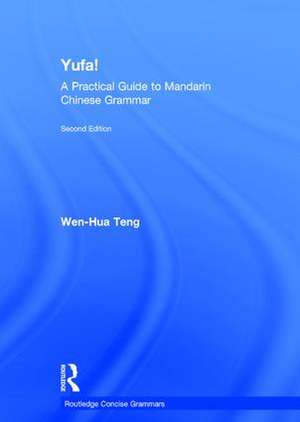Yufa! A Practical Guide to Mandarin Chinese Grammar: Routledge Concise Grammars
Autor Wen-Hua Tengen Limba Engleză Hardback – 9 noi 2016
- Chinese characters, pinyin and English translations
- Realistic scenarios to provide you with an interesting context in which to learn grammar
- Varied and imaginative exercises so you can review your progress easily.
With straightforward descriptions, numerous exercises, and examples that are rooted in realistic situations, the author shows you how grammar is used in everyday life.
| Toate formatele și edițiile | Preț | Express |
|---|---|---|
| Paperback (1) | 376.48 lei 3-5 săpt. | +34.15 lei 5-11 zile |
| Taylor & Francis – 4 noi 2016 | 376.48 lei 3-5 săpt. | +34.15 lei 5-11 zile |
| Hardback (1) | 771.13 lei 6-8 săpt. | |
| Taylor & Francis – 9 noi 2016 | 771.13 lei 6-8 săpt. |
Preț: 771.13 lei
Preț vechi: 1158.66 lei
-33% Nou
Puncte Express: 1157
Preț estimativ în valută:
147.58€ • 153.50$ • 121.83£
147.58€ • 153.50$ • 121.83£
Carte tipărită la comandă
Livrare economică 14-28 aprilie
Preluare comenzi: 021 569.72.76
Specificații
ISBN-13: 9781138651128
ISBN-10: 1138651125
Pagini: 400
Dimensiuni: 174 x 246 mm
Greutate: 0.84 kg
Ediția:2
Editura: Taylor & Francis
Colecția Routledge
Seria Routledge Concise Grammars
Locul publicării:Oxford, United Kingdom
ISBN-10: 1138651125
Pagini: 400
Dimensiuni: 174 x 246 mm
Greutate: 0.84 kg
Ediția:2
Editura: Taylor & Francis
Colecția Routledge
Seria Routledge Concise Grammars
Locul publicării:Oxford, United Kingdom
Cuprins
1 The basic formation of a Chinese sentence
2 The eleven types of question in Chinese
3 The use of □□, □□ and □□ and the definiteness of nouns
4 The functions of □□, relative clauses and noun clauses
5 Position words
6 Prepositional constructions
7 Imperative sentences and the use of □□
8 Chinese verbs
9 The progressive aspect and the continuous aspect
10 The use of □□ (the perfective aspect particle and
modal particle)
11 The use of □□ (the experiential aspect particle)
12 Modal verbs
13 The complement of state and the complement of degree
14 The complement of duration
15 The complement of quantity
16 The complement of direction
17 The complement of result
18 The complement of potential
19 The adverbial modifi er with □□
20 The □□……□□ structure
21 Subjectless sentences and existential sentences
22 The □□ structure
23 Passive structures
24 Making comparisons (1)
25 Making comparisons (2)
26 Measure words
27 Verb reduplication and adjective reduplication
28 The use of □□□□, □□□□ and □□□□
29 Modal particles
30 Conjunctive pairs
31 Conjunctions used in context
32 The use of □□ and □□
33 The use of adverbs in contracted sentences
34 The use of interrogative pronouns
35 Rhetorical questions
2 The eleven types of question in Chinese
3 The use of □□, □□ and □□ and the definiteness of nouns
4 The functions of □□, relative clauses and noun clauses
5 Position words
6 Prepositional constructions
7 Imperative sentences and the use of □□
8 Chinese verbs
9 The progressive aspect and the continuous aspect
10 The use of □□ (the perfective aspect particle and
modal particle)
11 The use of □□ (the experiential aspect particle)
12 Modal verbs
13 The complement of state and the complement of degree
14 The complement of duration
15 The complement of quantity
16 The complement of direction
17 The complement of result
18 The complement of potential
19 The adverbial modifi er with □□
20 The □□……□□ structure
21 Subjectless sentences and existential sentences
22 The □□ structure
23 Passive structures
24 Making comparisons (1)
25 Making comparisons (2)
26 Measure words
27 Verb reduplication and adjective reduplication
28 The use of □□□□, □□□□ and □□□□
29 Modal particles
30 Conjunctive pairs
31 Conjunctions used in context
32 The use of □□ and □□
33 The use of adverbs in contracted sentences
34 The use of interrogative pronouns
35 Rhetorical questions
Notă biografică
Wen-Hua Teng is Senior Lecturer, Department of Asian Studies, at the University of Texas at Austin, USA
Descriere
Yufa! A Practical Guide to Mandarin Chinese Grammar takes a unique approach to explaining the major topics of Mandarin Chinese grammar.




